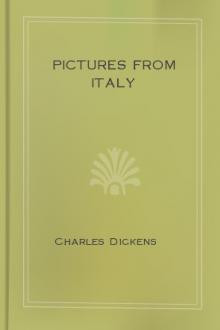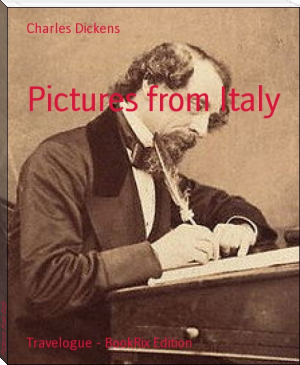Pictures From Italy by Charles Dickens (spicy books to read .TXT) 📕

- Author: Charles Dickens
- Performer: -
Book online «Pictures From Italy by Charles Dickens (spicy books to read .TXT) 📕». Author Charles Dickens
There is an upper chamber in the Mamertine prisons, over what is said to have been—and very possibly may have been—the dungeon of St. Peter. This chamber is now fitted up as an oratory, dedicated to that saint; and it lives, as a distinct and separate place, in my recollection, too. It is very small and low-roofed; and the dread and gloom of the ponderous, obdurate old prison are on it, as if they had come up in a dark mist through the floor. Hanging on the walls, among the clustered votive offerings, are objects, at once strangely in keeping, and strangely at variance, with the place—rusty daggers, knives, pistols, clubs, divers instruments of violence and murder, brought here, fresh from use, and hung up to propitiate offended Heaven: as if the blood upon them would drain off in consecrated air, and have no voice to cry with. It is all so silent and so close, and tomb-like; and the dungeons below are so black and stealthy, and stagnant, and naked; that this little dark spot becomes a dream within a dream: and in the vision of great churches which come rolling past me like a sea, it is a small wave by itself, that melts into no other wave, and does not flow on with the rest.
It is an awful thing to think of the enormous caverns that are entered from some Roman churches, and undermine the city. Many churches have crypts and subterranean chapels of great size, which, in the ancient time, were baths, and secret chambers of temples, and what not: but I do not speak of them. Beneath the church of St. Giovanni and St. Paolo, there are the jaws of a terrific range of caverns, hewn out of the rock, and said to have another outlet underneath the Coliseum—tremendous darknesses of vast extent, half-buried in the earth and unexplorable, where the dull torches, flashed by the attendants, glimmer down long ranges of distant vaults branching to the right and left, like streets in a city of the dead; and show the cold damp stealing down the walls, drip-drop, drip-drop, to join the pools of water that lie here and there, and never saw, or never will see, one ray of the sun. Some accounts make these the prisons of the wild beasts destined for the amphitheatre; some the prisons of the condemned gladiators; some, both. But the legend most appalling to the fancy is, that in the upper range (for there are two stories of these caves) the Early Christians destined to be eaten at the Coliseum Shows, heard the wild beasts, hungry for them, roaring down below; until, upon the night and solitude of their captivity, there burst the sudden noon and life of the vast theatre crowded to the parapet, and of these, their dreaded neighbours, bounding in!
Below the church of San Sebastiano, two miles beyond the gate of San Sebastiano, on the Appian Way, is the entrance to the catacombs of Rome—quarries in the old time, but afterwards the hiding-places of the Christians. These ghastly passages have been explored for twenty miles; and form a chain of labyrinths, sixty miles in circumference.
A gaunt Franciscan friar, with a wild bright eye, was our only guide, down into this profound and dreadful place. The narrow ways and openings hither and thither, coupled with the dead and heavy air, soon blotted out, in all of us, any recollection of the track by which we had come: and I could not help thinking ‘Good Heaven, if, in a sudden fit of madness, he should dash the torches out, or if he should be seized with a fit, what would become of us!’ On we wandered, among martyrs’ graves: passing great subterranean vaulted roads, diverging in all directions, and choked up with heaps of stones, that thieves and murderers may not take refuge there, and form a population under Rome, even worse than that which lives between it and the sun. Graves, graves, graves; Graves of men, of women, of their little children, who ran crying to the persecutors, ‘We are Christians! We are Christians!’ that they might be murdered with their parents; Graves with the palm of martyrdom roughly cut into their stone boundaries, and little niches, made to hold a vessel of the martyrs’ blood; Graves of some who lived down here, for years together, ministering to the rest, and preaching truth, and hope, and comfort, from the rude altars, that bear witness to their fortitude at this hour; more roomy graves, but far more terrible, where hundreds, being surprised, were hemmed in and walled up: buried before Death, and killed by slow starvation.
‘The Triumphs of the Faith are not above ground in our splendid churches,’ said the friar, looking round upon us, as we stopped to rest in one of the low passages, with bones and dust surrounding us on every side. ‘They are here! Among the Martyrs’ Graves!’ He was a gentle, earnest man, and said it from his heart; but when I thought how Christian men have dealt with one another; how, perverting our most merciful religion, they have hunted down and tortured, burnt and beheaded, strangled, slaughtered, and oppressed each other; I pictured to myself an agony surpassing any that this Dust had suffered with the breath of life yet lingering in it, and how these great and constant hearts would have been shaken—how they would have quailed and drooped—if a foreknowledge of the deeds that professing Christians would commit in the Great Name for which they died, could have rent them with its own unutterable anguish, on the cruel wheel, and bitter cross, and in the fearful fire.
Such are the spots and patches in my dream of churches, that remain apart, and keep their separate identity. I have a fainter recollection, sometimes of the relics; of the fragments of the pillar of the Temple that was rent in twain; of the portion of the table that was spread for the Last Supper; of the well at which the woman of Samaria gave water to Our Saviour; of two columns from the house of Pontius Pilate; of the stone to which the Sacred hands were bound, when the scourging was performed; of the grid-iron of Saint Lawrence, and the stone below it, marked with the frying of his fat and blood; these set a shadowy mark on some cathedrals, as an old story, or a fable might, and stop them for an instant, as they flit before me. The rest is a vast wilderness of consecrated buildings of all shapes and fancies, blending one with another; of battered pillars of old Pagan temples, dug up from the ground, and forced, like giant captives, to support the roofs of Christian churches; of pictures, bad, and wonderful, and impious, and ridiculous; of kneeling people, curling incense, tinkling bells, and sometimes (but not often) of a swelling organ: of Madonne, with their breasts stuck full of swords, arranged in a half-circle like a modern fan; of actual skeletons of dead saints, hideously attired in gaudy satins, silks, and velvets trimmed with gold: their withered crust of skull adorned with precious jewels, or with chaplets of crushed flowers; sometimes of people gathered round the pulpit, and a monk within it stretching out the crucifix, and preaching fiercely: the sun just streaming down through some high window on the sail-cloth stretched above him and across the church, to keep his high-pitched voice from being lost among the echoes of the roof. Then my tired memory comes out upon a flight of steps, where knots of people are asleep, or basking in the light; and strolls away, among the rags, and smells, and palaces, and hovels, of an old Italian street.
On one Saturday morning (the eighth of March), a man was beheaded here. Nine or ten months before, he had waylaid a Bavarian countess, travelling as a pilgrim to Rome—alone and on foot, of course—and performing, it is said, that act of piety for the fourth time. He saw her change a piece of gold at Viterbo, where he lived; followed her; bore her company on her journey for some forty miles or more, on the treacherous pretext of protecting her; attacked her, in the fulfilment of his unrelenting purpose, on the Campagna, within a very short distance of Rome, near to what is called (but what is not) the Tomb of Nero; robbed her; and beat her to death with her own pilgrim’s staff. He was newly married, and gave some of her apparel to his wife: saying that he had bought it at a fair. She, however, who had seen the pilgrim-countess passing through their town, recognised some trifle as having belonged to her. Her husband then told her what he had done. She, in confession, told a priest; and the man was taken, within four days after the commission of the murder.
There are no fixed times for the administration of justice, or its execution, in this unaccountable country; and he had been in prison ever since. On the Friday, as he was dining with the other prisoners, they came and told him he was to be beheaded next morning, and took him away. It is very unusual to execute in Lent; but his crime being a very bad one, it was deemed advisable to make an example of him at that time, when great numbers of pilgrims were coming towards Rome, from all parts, for the Holy Week. I heard of this on the Friday evening, and saw the bills up at the churches, calling on the people to pray for the criminal’s soul. So, I determined to go, and see him executed.
The beheading was appointed for fourteen and a-half o’clock, Roman time: or a quarter before nine in the forenoon. I had two friends with me; and as we did not know but that the crowd might be very great, we were on the spot by half-past seven. The place of execution was near the church of San Giovanni decollato (a doubtful compliment to Saint John the Baptist) in one of the impassable back streets without any footway, of which a great part of Rome is composed—a street of rotten houses, which do not seem to belong to anybody, and do not seem to have ever been inhabited, and certainly were never built on any plan, or for any particular purpose, and have no window-sashes, and are a little like deserted breweries, and might be warehouses but for having nothing in them. Opposite to one of these, a white house, the scaffold was built. An untidy, unpainted, uncouth, crazy-looking thing of course: some seven feet high, perhaps: with a tall, gallows-shaped frame rising above it, in which was the knife, charged with a ponderous mass of iron, all ready to descend, and glittering brightly in the morning sun, whenever it looked out, now and then, from behind a cloud.
There were not many people lingering about; and these were kept at a considerable distance from the scaffold, by parties of the Pope’s dragoons. Two or three hundred foot-soldiers were under arms, standing at ease in clusters here and there; and the officers were walking up and down in twos and threes, chatting together, and smoking cigars.
At the end of the street, was an





Comments (0)